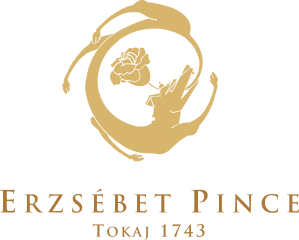Hajnalka Prácser greets us as we step into her family’s small winery on Bem St. in Tokaj. She has kind eyes and a warm smile, framed by shoulder length blonde hair. My wife and I are here to taste on a cold Saturday in March. Unable to find a babysitter, our 14 month old son is along for the ride. Two other visitors are already inside waiting for the tour. With introductions we discover they’re Americans, now living in Budapest. Moments later Hajnalka is leading us past stainless steel tanks and into the adjoined low-cielinged cellar.
“Watch your heads”, warns Hajnalka. “As you can see we have lots of mold here. A lot of cellars don’t have this and people think it is bad for hygiene. But it does not contact the wine. It regulates the temperature of the cellar and controls the environment.” A layer of fluffy, dark mold blankets the walls and ceiling. To my left and right, stacked bottles of Tokaji Aszú glow like gold bars in adjacent passageways; treasures hidden away from the world. “This cellar was dug out in the 1600’s,” Hajnalka continues. “And this street was the original wine merchant street in Tokaj.”
Leading us deeper down a small side passage, Hajnalka then shows us a dusty bottle of 1993 5 Puttonyos Aszú. “My mother founded the estate in 1989 and this was our first vintage, and the only wine we made that year.” Under dim light, a collection of old Tokaji bottles occupy shelves on either side. Many of the labels are unreadable due to dust and the elements.
On our way back to the tasting room I look down and see handwritten labels atop the knee high stacks of Aszú bottles. They read ‘Király Dűlő’ and ‘Betsek Dűlő’, two of Tokaj’s most prestigious Grand Crus.
Wolves, Roses, a Tsarina and Botrytis
The Tokaj region has its share of historical cellars, yet Erzsébet Pince’s story is surely one of the most compelling. The winery itself dates back to 1743 and the cellar was rented by Russian Emperors, including Tsarina Elizabeth. At the time Tokaj’s decadent botrytis sweet wine, Tokaji Aszú, was highly prized by Europe’s royalty and upper classes. Sugar was a rare commodity and this golden-amber liquid was seen as a kind of elixir. One must realize, however, that the term ‘sweet’ does not do these wines justice but we’ll get to that later.
Tsarina Elizabeth (Erzsébet in Hungarian, which also happens to be Hajnalka’s mother’s name) thought highly enough of her Aszú to have a dedicated regiment of troops guarding her stash. Legend has it that barrels of Aszú being transported back to Russia in winter needed defense against bandits, and packs of thirsty wolves.
Erzsébet Pince sits nestled into a hillside right over historical downtown Tokaj, once known as the ‘Rose District’ for its abundance of roses. Today, the winery’s logo displays a rose encircled by a wolf biting its own tail. Hajnalka manages marketing, sales and hospitality. Her brother Miklós is the winemaker. Their parents, Miklós Sr. and Erzsébet, are lifelong students of the vine. After studying viticulture and oenology, then working for the state run wine company, they began buying parcels for their own estate in 1979. By 1989, Erzsébet Pince was born. Just down the street from the winery, near Rákóczi Square, the family also runs the Tokaj Coffee Roasting Company.
Besides its royal history, more recent development and activity by the Prácsers, Erzsébet Pince now has the help of a bonafide wine expert, if ever there were one. Originally from California, Ronn Wiegand is both a Master of Wine and a Master Sommelier. He was the first person in the world to attain this double certification and one of only 4 people in the world to do so. He and Hajnalka married and have lived in Tokaj since 2010. Wiegand helps where he can, especially with blending wines.
The Estate
The Erzsébet estate produces 10,000 bottles annually. Production is roughly 60% dry and 40% sweet, depending on the vintage. Furmint, Hárslevélű and Muscat Blanc dominate plantings. Kabar and Zéta are also grown. Erzsébet farms 9 hectares from premier and grand cru sites in Tarcal, Mád, Bodrogkeresztúr and Tokaj. All grapes are hand harvested.
Erzsébet Pince is anything but ordinary. From outside, their small stone building is unassuming and plain. Inside, however, a story begins to unravel leading to a fascinating tale of past glories, modern mastery and the continued polishing of an almost lost treasure.
Tasting Notes
Earlier I mentioned the fact that ‘sweet’ really is a misnomer when it comes to Tokaji Aszú. Yes, these wines are luxuriously sweet, often with 200 gr of residual sugar. Yet, when you smell and taste a good Aszú you’re met by seemingly never-ending complex layers of fruit, nuts, preserves and herbs. And what really balances out that sweetness is a backbone of acidity that keeps things fresh and vibrant. If you’ve never experienced Aszú, I encourage you to find a quality bottle of 5 or 6 Puttonyos, and share it with friends.
2016 Luneé Sárgamuskotály (Muscat Blanc) – Alc. 11.5%
Semi-dry with pronounced aromas of grape, elder flower, white blossoms and pear. Similar on the palate with noticeable spice. Beautiful finish. Very nice example of a variety that I’m liking more and more.
2016 Estate Furmint-Kabar -Alc. 13%
Prominent flintiness, lime, lemon and acacia. Very fresh and lively. Some peach and pear with lingering salinity. Elegant and well structured.
2016 Zafír Dűlő Furmint-Hárslevelű -Alc. 12.5%
80% Furmint and 20% Hárslevelű blend from the Zafír vineyard. 6 months in barrel. Lemon, green apple, pear and peach on the nose. On the palate lemon-lime, more green apple, grapefruit and of course flint and salt. Delicate structure and medium-long finish.
2016 Betsek Dűlő -Alc. 14%
100% Kabar from Betsek Grand Cru. Perfumed nose with mineral character. In the mouth fuller body, nectarine, peach skin, flint and a satisfyingly long finish. An interesting wine no doubt.
2016 Király Dűlő Furmint -Alc. 13%
100% Furmint from the Király Grand Cru in Mád. Right away you notice this is a more intense, concentrated wine. Aromas are anchored by minerals, acacia and lemon. Acidity through the roof. Riper and more pronounced flavors of peach, apricot, lemon, green apple, pear. Notes of vanilla and toast. Long flinty, salty finish. Very balanced. This one can age for sure!
2013 Sweet Szamorodni
Aromas are led by botrytis characteristics of honey, candied orange, dried apricot and some acacia and ginger. Obvious oxidative qualities giving depth and a touch of almond. Flavors of dried pineapple, apricot and a subtle toasty note. Really lovely wine.
2013 Forditás
120 gr residual sugar. Aged for one year in oak. Made from Aszú berries but on the second soaking—you could say it’s Aszú on a budget. Nevertheless, a beautiful wine: Very pronounced nose of dried fruits like apricot, peach and lemon. Sweet spices like ginger and a touch of medicinal herbs. Matching flavors with added notes of nuttiness and a solid line of acidity giving a stretching finish reminiscent of a perfectly made lemonade.
2013 6 Puttonyos Aszú -Alc. 9%
Now we’re in the heavyweight division. 225 gr residual sugar and two years in the barrel. Deep lemon-gold color. Rich aromas of honey, candied ginger, honeysuckle and almond. Palate: rich with ripe and dried stone fruits, more ginger, peach jam and lemon. Herbal notes. Keeps opening up with some time. Great acidity which leaves the mouth rather clean, not sugar coated. Excellent. This one can last for decades.
2003 Aszú Eszenciá -Alc. 10.5%
A real treat. Amber in color and three years spent in barrel. Very complex with oxidative nutty notes and marzipan. Golden raisin, dried apricot, ginger and a wonderful marmalade bitter-sweet combo. Peach jam and peach skin. Sweet pipe tobacco. Defined acidity still playing a major role. This wine will outlive us all!
Forrás: http://paprikaproject.com/2018/03/28/erzebet-pince-wolves-roses-a-tsarina-botrytis/

 HU
HU  EN
EN 
